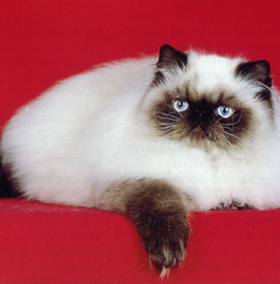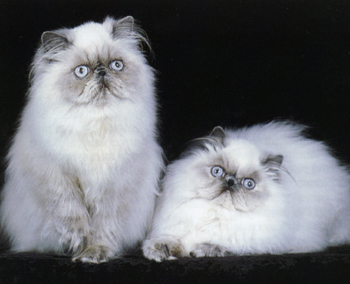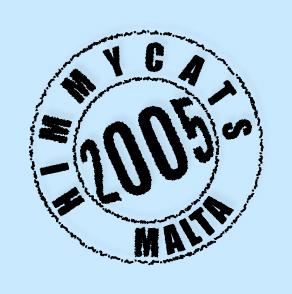 Researchers are not sure where the Persian (the other breed in the Himalayan equation) originated from. They think the gene for long hair appeared as a spontaneous mutation in the domestic cat population in the mountainous areas of Iran, then called Persia, for which the Persian cat was named. Researchers are not sure where the Persian (the other breed in the Himalayan equation) originated from. They think the gene for long hair appeared as a spontaneous mutation in the domestic cat population in the mountainous areas of Iran, then called Persia, for which the Persian cat was named.
In the sixteenth century, the Romans and Phoenicians transported Persian cats to continental Europe and eventually to Britain. Persian cats quickly became popular for their long coats and sweet temperaments and were one of the breeds exhibited in early cat shows. In the early 1900s, the Governing Council of the Cat Fancy (GCCF) in Britain decided that all long-haired cats - Persians, Angoras and longhaired Russians - would be grouped under the name longhair, with each colour constituting a separate breed. This policy continues today.
In 1924, a Swedish geneticist made the first attempt at a deliberate crossing between a Siamese and a longhaired cat. Six years later, two Harvard medical employees crossed a Siamese female with a black Persian male, not to create a new breed, but to study genetic colour inheritance. A litter of black, shorthaired kittens resulted. They then bred a black Persian female with a Siamese male with the same outcome.
However, by crossing a female from the second litter with a male from the first, they produced Debutante, the first pointed pattern longhair which had the Siamese body type like today's Balinese breed. (The Himalayan should not be confused with the Balinese or Javanese; these longhaired pointed breeds have the Oriental body type of the Siamese rather than the cobby type of the Persian). At this point the Harvard employees ended their experiment, but breeders in England took up the torch and began their own Persian/Siamese crosses. These breeders hoped to produce a cat with the Siamese pointed pattern and the popular Persian hair and body type.
During the World War 2 years, interest in the breeding program waned. But in 1950, American breeder Marguerita Goforth succeeded in creating an entirely new longhaired breed, one with the Siamese beautiful coat colour and pattern and the Persian popular body type. Five years later the Governing Council of the Cat Fancy (GCCF) recognised the Himalayan under the name Colourpoint Longhair. The American Cat Fanciers Association (ACFA) recognised the breed under Himalayan in 1957. The breed was so named for the Himalayan pointed pattern found in other animals such as the Himalayan Rabbit. By 1961 all major cat associations recognised the Himalayan.
Today the Himalayan is recognised as a separate breed by the American Association of Cat Enthusiasts (AACE), the American Cat Fanciers Association (ACFA), the Cat Fanciers Federation (CFF), the National Cat Fanciers' Association (NCFA) and The International Cat Fanciers Association (TICA). The American Cat Association (ACA) and the Cat Fanciers' Association (CFA) recognised the Himalayan as a colour division of the Persian, and refer to the breed as the Pointed Pattern Persian. Cats who carry the colourpoi nt gene but look like Persians are called Colour Point Carriers (CPC) and are given a separate identification number. In combining the breeds, CFA made Himalayan/Persian hybrids eligible for championship competition. The NCFA (and others) disagree with this policy and originally formed to promote the Himalayan as a separate distinct breed. nt gene but look like Persians are called Colour Point Carriers (CPC) and are given a separate identification number. In combining the breeds, CFA made Himalayan/Persian hybrids eligible for championship competition. The NCFA (and others) disagree with this policy and originally formed to promote the Himalayan as a separate distinct breed.
What makes the Himalayan cat special is that, no other cat in the history of the cat fancy has so captured the admiration of cat lovers the way the Himalayan has! Siamese in colour, Persian in type and combining the best qualities of both breeds in one magnificent creature, the "rare new breed" has endeared itself to all people who profess to love cats........
Less but not least today, there is so much good breeding stock available through established lines that it is no longer necessary to go back to Persian or Siamese breeding stock. Our Himalayan cats today continue to improve on all points, and some truly magnificent specimens are being seen and are winning top honors at the cat show, all over the world!
THE HIMALAYAN GENE EXPLAINED
All Himalayan kittens are born white and develop their point color as they get older. The pointed pattern is a result of the partial albinism gene. This point restricted pattern came about from a genetic mutation that is responsible for producing the enzymes that produce pigment. When this mutated enzyme is subjected to temperatures above 98°F (37°C), the cells of the hair root will produce little or no pigment for the growing hair. The neck and the body of the cat are warmer and don't develop any pigment. Thus, their point color is restricted to the areas of the body that are cooler, such as the extremities (face, ears, legs, and tail). There also several "modifying" genes that can further affect the color and density of the points.
A Himalyan cat that is overweight tends to be darker because the extra layer of fat insulates the skin from the body, thus causing it to produce more pigment. Kittens are white when they are born because the temperature inside the womb is very warm. Color can also vary with each individual cat. Anything that affects the temperature of the Himalayan can also affect their point color. A Himalayan that has been ill will often show "ticking", or lighter colored hairs in it's mask because the actively growing hairs will be un-pigmented in the elevated temperature of a fever.
The blue eye color of a Himalayan is also due to the partial albinism gene. Himalayans have little to no pigment (yellow-brown) in their eyes and the blue color is actually a result of reflected white light from the retina. This is called Tyndall's phenomenon. The eye color can range from a pale china-blue to a deep blue-violet.
Himalayans darken as they age. At HimmyCats, I show in Malta Feline Fanciers (FIFe) exclusively, and the accepted colours are Seal, Blue, Torties (blue tortie & black tortie), Cream, Red, Chocolate, Lilac and if these cats have tabby markings, they are called Lynx. Example: Blue Lynx Point or Blue Lynx Himalayan.
HOW I GOT IN THE HIMALAYAN WORLD AND EVENTUALLY STARTED HIMMYCATS CATTERY
I am Kevin Davison, where we live in this beautiful island of Malta, found in the middle of the Mediterranean sea. In 1995, we had started a small cattery of three cats, which consisted of a Silver Tabby, a Black Tortoise Shell and a Mackerel Tabby. The cats we had at that time were not of the show standard we always wished to have but since at that time we could not even show, or be a member of any cat club, meaning - no registration of pedigrees and catteries possibility we were quite stuck in a position that if we had to improve our cats we still had nowhere were to advance.
One can imagine what a mess there was in the Maltese Cat world. Unfortunately today, 10years after, there are still people selling cats with half mixed or quarter mixed, which in my opinion these people what they do is simply set backward all the work and efforts done to produce the Persian type as we have it today. As a result to this, the value of a longhair Persian with that "peak face" had diminished. People did not give attention to qualities of a pure bred persian, but the attitude was, to have a hairy cat for the kids. In 1999, we decided to cease our breeding program due to the lack of un-professional resources as mentioned above as well as to our migration to the US.
Back in Malta in 2002 we realised that things were changing and real clubs were holding several shows during the year, under the auspices of FIFe, WCF and TICA. We also noticed that some real cat lovers were emerging and selective breeding was taking place. After visiting Moscow for a vacation, where it is home to some of the world's top Himalayan breeders (like Brigantina and Juky), we attended to the annual CFA cat show, and this is where we fell in love with Himalayans for the first time. From that time onwards we never looked back, and we made researches and attended seminars, invested in books, never missed a show in Moscow and Belgium. We also made it a point that we had to learn more about this wonderful breed, and thus becoming breeders. Thanks to our past cats which we certainly we will never forget, as they were the foundation of our knowledge in breeding cats.
Today in 2007, we breed Himalayan Cats under the prefix of HimmyCats Cattery which is the abbreviation of Himalayan Cats (American version for Colourpoint). HimmyCats is the first and ONLY Himalayan Cattery ever registered in Malta. Our cattery is registered with FIFe and our registration number MT0119MFF. Our cattery is our house, since all our cats have the freedom to move all around, this is what gives our cats all the human friendliness and sweet temperament. We would like to thank Mr David and Daisy Dedobeeler from Belgium, who entrusted us with their beautiful cats, all Top Show with winning lines of Grand Champions & Grand International Champions. Most of our cats come from best winning bloodlines one can find in the Himalayan world, such as-: Juky, Careyata, Brigantina, Teahs, Karabel, Demiara, Alina, Persian House, Ali Baba, Oakheaven, Alomi, Le Club Fur, Dragonfyre and less but not least Whisperwood. Although we breed himalayans for the past 3 years and our cattery is pretty young, we are certainly proud that our cats come from generations of breeders who has been in the Himalayan world for the past 25-30years. In our breeding program we mainly concentrate on the excellent type, strong bones, super head type, very strong wide paws, and certainly with very long, dense, and luxurious coat of silky structure. Our cats are dark in their extremities and of a sphere round, big and deep blue eyes. All our cats have features which reach the highest standards of the breed as all the big cat clubs request. Each kitten has a completely tremendous appearance and a curiously individual character.
In 2005 we decided to set up this informative website dedicated to all the Himalayan Cat world, keeping it updated will all health and grooming issues as well as with the latest news of our show results. The website contains a page with articles covering cat health information being either a simple flea topic to the most deadly cat diseases. We also was invited on several occasions to write on local newspapers as well in a magazine in Norway. We have had also several interviews about our cats on local TV and Magazines.
We are proud to say that we house 6 winning cats of FIFe Champions and CFA Grand Champions, with winning titles from Best in Shows to Best of Classes. All our breeding cats are out of PKD negative parents and tested PKD, FELV, FIV and FIP negative. We breed our beloved cats with strong health and an incredible gentle character, with an exterior which corresponds to the breed's standard and finally with a sweet open expression of a very beautiful face. In each kitten we produce we are always truly satisfied to see, the delightful sweet expression on their charming faces which reflects the features of their lovely father Vassily or the wonderful sweet temperament of our young male Tzaro. According to my wife, it is not simply cats that ROAM FREELY and live in our house, but friends and companions which we love infinitely. WE ARE STRONGLY AGAINST CAGED CATS, being in Catteries or any kind of confinement. Having a look at our babies in our kittens page, you will receive feast for your eyes. Our kittens are wonderful and of excellent type, with strong bones, Super head type, very strong and wide paws, and certainly with very long, dense, and luxurious coat of silky structure. My cats are dark in their extremities and of a sphere round, big and deep blue eyes. All my cats have features which reach the highest standards of the breed as all the big cat clubs request. Each kitten has a completely tremendous appearance and a curiously individual character. Himalayans and Persians are the most docile and graceful animals in the feline family. Show or Pet kittens are occasionally available to permanent loving and selected homes ONLY.
Well, we are not going to bother you anymore with something that easily could turn into a whole novel, instead we wish to invite you have a warm stay on our webiste. Please come back for regular updates and exciting new additions! We hope you will enjoy viewing our web-site. Please feel free to contact us with any questions regarding upcoming litters or kittens available now. We'll be very glad to read what you think about our charming cats and web-site.
Contact
Kevin Davison
Republic of Malta, Europe
Cell +356 9947 0907
|